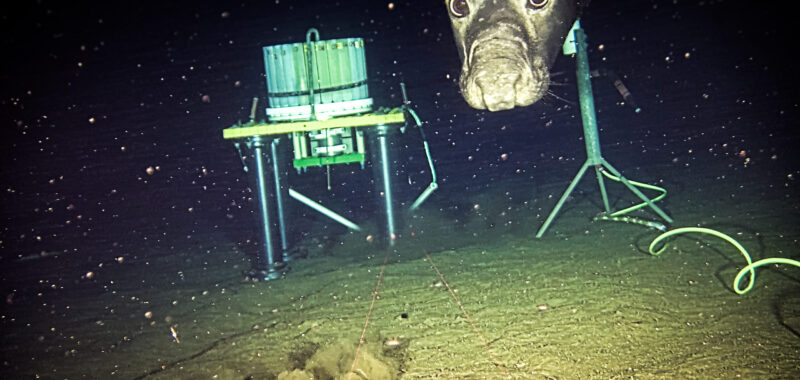While studying how light affects baitfish in Berkley Canyon off the Pacific coast of British Columbia, Canada, an international team of scientists was in for a big surprise. Several young male northern elephant seals were caught on camera and detected by hydrophones. They appeared to be using the underwater observatory as a place to forage for fish.

An elephant seal forages for fish near an underwater observatory called in Berkley Canyon off the coast of British Columbia. This subsea lab named NEPTUNE is over 2,000 feet deep and a team of scientists observed the seal’s feeding behaviors, prey preferences, and resting habits all by chance. CREDIT: Ocean Networks Canada
The chance encounter gave scientists a glimpse into this marine mammal’s deep-sea behaviors, sophisticated feeding strategies, preferred prey, and resting habits. The findings are detailed in a study published September 4 in the journal PLOS ONE.
A slippery seal
Scientists at one time believed that northern elephant seals were extinct due to commercial sealing during the 1800s. They are now considered a species of Least Concern due a large and growing population and growing range.
“The northern elephant seal, named for its long, elephant-like nose (called a proboscis), is the largest of the true seals (phocids) in the Northern Hemisphere,” Héloïse Frouin-Mouy, a study co-author and marine biologist and bioacoustician at the University of Miami and a visiting professor at the University of Victoria in British Columbia, tells Popular Science. “Renowned for their remarkable diving abilities, northern elephant seals can dive to depths of up to 1,735 meters [5,692 feet] and remain submerged for nearly two hours.”
[Related: Seals snooze during 20-minute ‘sleeping dives’ to avoid predators.]
Every year, northern elephant seals migrate from their molting and breeding sites in California and Mexico, to their feeding grounds in the North Pacific Ocean. Their long-distance migrations and deep-diving behavior has primarily been tracked with adult female northern elephant seals because they have higher survival rates, return to the same sites more often, and are easier to handle when placing satellite trackers.
There is less data available on male northern elephant seals, with even less known about sub-adult males. These are males who have passed through their juvenile stage, but are not yet fully developed into an adult.
Ringing the ‘dinner bell’
Between 2022 and 2023, at least eight male elephant seals, ages four to seven, were seen on camera and detected by hydrophones at Ocean Network Canada’s subsea cabled observatory NEPTUNE. It is over 2,000 feet deep and equipped with a high-definition camera, acoustic imaging sonar, hydrophone, pair of LED lights, and automatic bait release.
“Sonar videos revealed that the seals were taking short naps when visiting the site, while camera footage provided insights into their prey selection, showing that sablefish is their preferred meal,” says Frouin-Mouy. “Interestingly, several seals were recorded on both camera and hydrophone, bobbing their heads and producing low-frequency sounds while chasing prey.”
Four individuals made repeated visits to the site over 10 days, with one staying 30 days, which Frouin-Mouy says was quite unexpected. The repeated presence suggested that the mammals were not only attracted to the site, but could precisely locate a small area in the open ocean, that is shrouded in complete darkness, and do this multiple times.
[Related: Hungry seals may have begun following their whiskers 23 million years ago.]
“It is suspected that the seals have learned to associate the noise produced by the sonar with the presence of food—a phenomenon known as the ‘dinner bell’ effect,” says Frouin-Mouy.
Whenever it was possible, the team identified individual elephant seals based on their visible body marks or scars, and the distinctive eyeliner markings that are located near their eyes while they’re at sea. In total, they identified eight sub-adult male elephant seals.
“[The seals] were named after members of the Beach Boys to track the frequency of their visits and their observed behaviors,” says Frouin-Mouy.
Mike–named for Beach Boys vocalist and songwriter Mike Love–visited the site over the longest period and was spotted 20 times on nine different days from September 30, 2022 to October 29, 2022.
The data collected at this deep sea observatory is currently open to anyone and a resource for citizen science and classrooms. Frouin-Mouy is working on the possible presence of harbor seals at another underwater site monitored by Ocean Network Canada. Study co-author Rodney Rountree is currently also analyzing the interactions between snailfish and crabs at this site, which was one of the original aims of this study. Additionally, the results from a fish acoustics experiment study will also be published in the near future.
“My work as a marine biologist and bioacoustician focuses on studying and understanding the behavior and ecology of elusive marine mammals using both passive and active acoustic techniques,” says Frouin-Mouy. “By leveraging advanced technology and scientific methods, I can gain insights into species that are often hidden from view, contributing to our understanding of ocean health and the complex relationships within marine ecosystems.”

